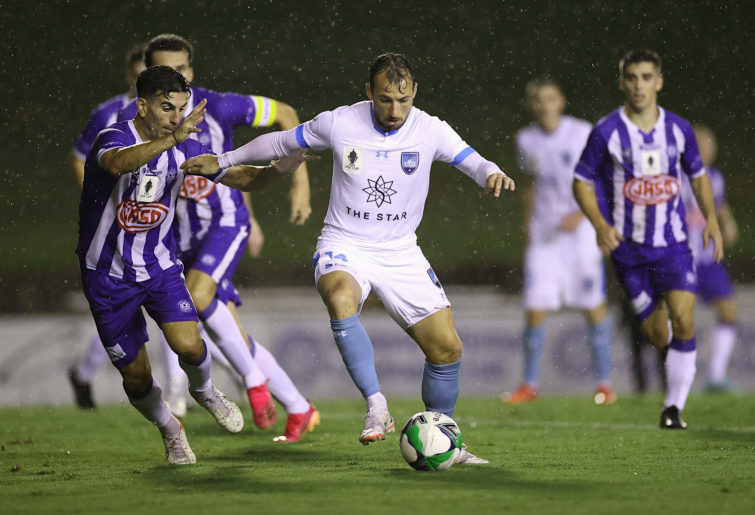On Tuesday, the Association of Australian Football Clubs (AAFC) released its proposal for a new second tier, A Genuine National Second Division of Football in Australia.
The AAFC’s National Second Division (NSD) model, proposed to commence next year, would be one of the most significant structural reforms of any Australian sport this century, so naturally it’s been ignored by every major media outlet.
To be fair, it’s only a proposal. The AAFC has indicated it’s open to negotiating at least some of the details and Football Australia is yet to respond.
The proposal frames the case for a NSD in terms of the frustration of the best state premier league clubs at being stuck in provincial backwaters with limited growth prospects, the need to establish a link between the A-League and football’s grassroots and, in the process, increase the number of full-time professional players in Australia.
It also includes some sound analysis about the broader benefits and costs of a ‘genuine’ NSD but does present Football Australia with some open goals to shoot for a less ambitious model.
In the next few months, the AAFC’s 32 ‘partners’ would be whittled down to a group of 12 founding members of the NSD.
The select group would be those who stack-up best against an agreed set of licensing criteria, but the report also focuses on the need for broad geographical dispersion, including to capital cities and populous regions not currently served by an A-League Men’s club.
However, the dispersion objective appears subordinate to licensing criteria and it’s not clear how the proposed NSD would expand beyond the A-League Men’s footprint or, most importantly, avoid becoming increasingly concentrated in major population centres over time.
Whatever the case, the plan is for the NSD to add four additional teams across its commencement phase in 2024 and ’25. The details of how expansion would work are not strictly defined. Licensing criteria would be a factor and founding clubs could be subject to relegation immediately.

(Photo by Cameron Spencer/Getty Images)
The following three seasons would be a period of consolidation and development, with a women’s NSD also expected to commence in 2026.
The AAFC expects increased interest and revenue from supporters and media over this period, along with implementation of a domestic transfer fee system and grants from governments to upgrade the facilities of NSD teams and ambitious premier league clubs.
While these are not entirely unrealistic expectations, it’s here the proposal moves onto shaky ground.
The AAFC’s financial modelling indicates a 12-team second division would likely break even but that expansion would see a significant increase in travel costs, the single biggest item on that side of the ledger. It’s expected that these costs would be largely, if not entirely, met by Football Australia.
The most notable absence from the proposal is modelling about the potential benefits of a 16-team NSD, especially as it reaches its proposed maturity phase in 2029 and fully integrates with the A-League, including promotion and relegation.
It’s here one of the big consultancy houses – or even a firm like Gemba which recently assessed the case for NRL expansion – could’ve really helped. It’s also where Football Australia will likely pick the proposal apart.
As far as we know, Football Australia’s preference is for a Champions League-style ‘NSD’, at least to begin with. If you’re unfamiliar with what such a model might entail, I suggest reading page 20 of the proposal.
The AAFC rightly derides this model. Its participants would still be competing in state premier leagues and so it doesn’t constitute a second-tier league. While it would involve as many as 106 fixtures in total, most clubs would play either eight or 11 games.
On the other hand, it would be a genuinely national tournament and wouldn’t accrue the costs of meaningless late-season league fixtures between teams out of contention for the title.
It’s now worth mentioning that the AAFC considered a third model: a 16-team NSD with the teams split into northern and southern conferences.
The northern conference would include teams from Sydney, Wollongong, Newcastle and south-east Queensland. The southern conference would include teams from Melbourne, Canberra, Perth, Adelaide and Hobart.
The AAFC is lukewarm about the idea and there are good reasons for this. It’s not quite a national league and no matter how you divide the teams geographically, there’ll always be an imbalance. Perth isn’t about to move any closer to the east coast.
The most interesting aspect of the proposal is that the AAFC is deliberately inflexible about the details of a conference system.
It wouldn’t have to start at 16 teams, the geographical split doesn’t have to be north-south or even set in stone and teams don’t have to play exclusively against members of their own conference.
The AAFC’s modelling indicates a conference system would be significantly less expensive than its preferred 16-team NSD model, but also involve fewer fixtures and less potential revenue.
How many games, how many dead rubbers and how much travel are likely to be among the key topics in negotiations.
Like the federal government negotiating funding with the states, Football Australia has most of the leverage, but it’s also said the NSD is not a case of ‘if’ or even ‘when’.
Watch this space.





























































































